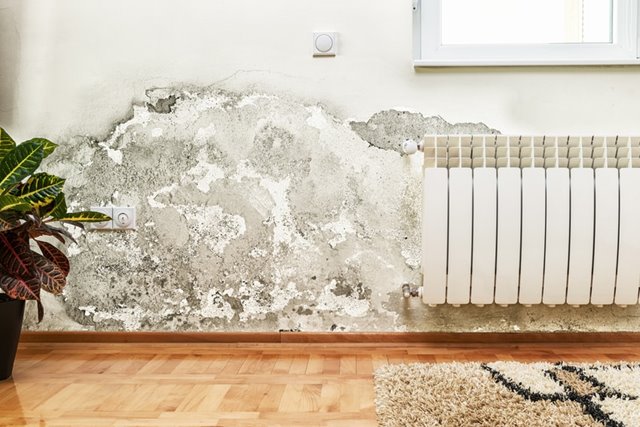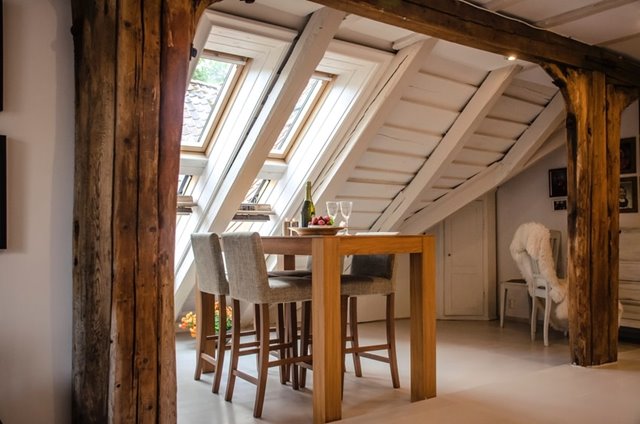Mould in your house? Find out how to remove and prevent mould.
Black spots or stains on your bathroom ceiling. Brown rings or damp patches on your kitchen walls. They’re both silent clues that mould is getting a hold on your home. While not exactly a reason to panic, it’s still best to take action as quickly as possible. Mould — some of which is harmful, while other types are less so — is present in nearly every home. Luckily, there’s good news too: it’s easier than you think to prevent mould in your home. How? By using ventilation to create a healthy indoor climate!
Before we delve deeper into how to remove and prevent mould in your home, let’s take a closer look at how it forms. Mould can make its way into your home much more easily than you think. The only thing it needs to survive is high air humidity. And that brings us to the reason why your bathroom ceiling is one of the first places you might notice mould in your home: the water vapour released while you take a shower rises and forms condensation on the cold ceiling. Poor bathroom ventilation is the main contributor to this. By the way, did you know that the average family generates around eight litres of water vapour per day? All simply by cooking, bathing, breathing and sweating! If you’d like to measure the air humidity level in your home, Renson Sense, our smart CO2 monitor, is the perfect way to do so.
Another factor that can’t be overlooked is that our homes are much better insulated than they once were. As a result, moisture can’t find a way out, and mould in the home is the inevitable consequence. Hopefully, this has made it clear just why ventilation is so important; important enough for the government to set specific requirements for newbuild or extensive renovation projects. Without a ventilation system, damp problems around the home will occur sooner or later.

The stains caused by mould in the home don’t exactly look pretty, but the consequences go much further than what you see with the naked eye. A few dark patches on the wallpaper or plasterwork in rooms were damp is gaining the upper hand might be all you see at first, but as damp penetrates deeper and deeper into your walls and ceilings, it weakens the structure of your home. The consequence is that the surface finish starts to crumble or come loose. Extra vigilance is required for wooden structures: when wood is affected by damp, the consequences aren’t immediately visible from the outside. On the inside, however, the wood could well be rotting away. The consequences can be pretty nasty, but they can be avoided — on the condition that you take action early on.
If your home is affected by the type of fungus that causes dry rot — older homes are particularly at risk here — the rotting process will take hold much more quickly. In this case, it’s especially important to check your joists and roof to prevent things from getting any worse.

It should be clear by now that mould can cause a significant amount of damage to your home. But structural elements aren’t the only ones to suffer: for residents too, the impact of mould often goes far beyond the proverbial thorn in the side. Research has shown that breathing in fungal spores can cause several symptoms. They can even cause certain rare conditions, such as allergic sinusitis (which can also be triggered by dust mites in the home). The most common problems are:
- Breathing difficulties
- Respiratory infections and coughing
- Asthma and other allergies
- Itchiness and skin irritation
- Headaches and/or migraines
Consequently, the impact of mould on your health cannot be ignored — especially where small children or people with weak immune systems are concerned. As a result, proper ventilation is indispensable to protect the most vulnerable people in your home. We’ll take a closer look at this further on in this article.
Mould is caused by fungi, which are organisms that can be found literally everywhere: in the air, in water, on plants, and unfortunately, in our homes. Around 100,000 different species of fungi have been discovered, but scientists estimate that this only accounts for around 5% of the total number of species there are. There are around ten types of fungi that regularly make their way into our homes, and the five most common types are listed below:
- ALTERNARIA: this fungus causes brown stains on organic materials and fabrics (such as mattresses and bedding). It has been known to aggravate allergies and lung conditions in people.
- CLADOSPORIUM: appears in clusters of dark spots, but is not particularly harmful to people. That said, this mould is a true expert at spreading quickly!
- WET ROT: this group of fungi mainly appear as external rot on wood and walls in your cellar. The spores spread in a fan shape. Can cause respiratory infections and breathing difficulties.
- DRY ROT: one of the most dangerous moulds for your home, the presence of this fungus can be seen by wood getting darker and darker in colour. Breathing in these fungal spores can cause a range of health problems, from breathing difficulties to general weakening of the immune system.
- BLACK MOULD: the most common type of mould in the home! This type of fungus appears on damp walls in the form of small black spots. Black mould is highly toxic and can seriously affect your lungs.
Once these uninvited guests make their way into your home, it’s best to kick them out as quickly as possible. If you decide to scrub them off, make sure you use a face mask and gloves! Supermarkets and DIY stores offer a range of well-known anti-mould products that are quick and easy to use, and most important of all, highly effective. Another common way to remove mould in the home is to spray white vinegar directly onto the stains. It’s best to allow the vinegar to sit for around an hour before you start scrubbing and rinsing with plenty of water. Baking soda can also help and is highly environmentally friendly to boot. Simply dissolve around five grams of baking soda in 25 ml of lukewarm water and spray it onto the areas to be treated. Allow the mixture to sit for around an hour, scrub using a hard brush and wipe down with a damp cloth.
One important thing to remember is to not just treat the stains themselves, but to cover a large area around them. After all, mould might already be present, even before you can see it! If your mould patches are too tough to remove or if they reappear quickly, make sure you contact a specialist to tackle the root of the problem.
Of course, prevention is always better than cure. And there’s some good news here: preventing mould in your home is easy. The best way to prevent damp (condensation) is by ventilating. Lots of people do so by opening one or more windows around the house. While this certainly has a positive impact, it’s often not enough to solve the problem. Every home can use the helping hand provided by a mechanical extract ventilation system to extract dirty and excessively humid air and replace it with fresh outside air. A good C+ ventilation system (system 3), such as Healthbox 3.0, restores balance to the composition of your air.
Getting some help from ventilation to keep the indoor air healthy is a must for every home. If you’ve already applied the last few finishing touches to your home, you’re unlikely to be enthused by the prospect of installing a centralised ventilation system. Fortunately, renovation solutions are available too, such as Renson Waves: a fan for bathrooms and other wet rooms around your home. Waves can easily be integrated into existing air ducting.
The perfect ventilation system for your home depends on several factors, so make sure you enlist an expert to help. Contact our Renson specialists today to stop mould before it even gets a chance!
